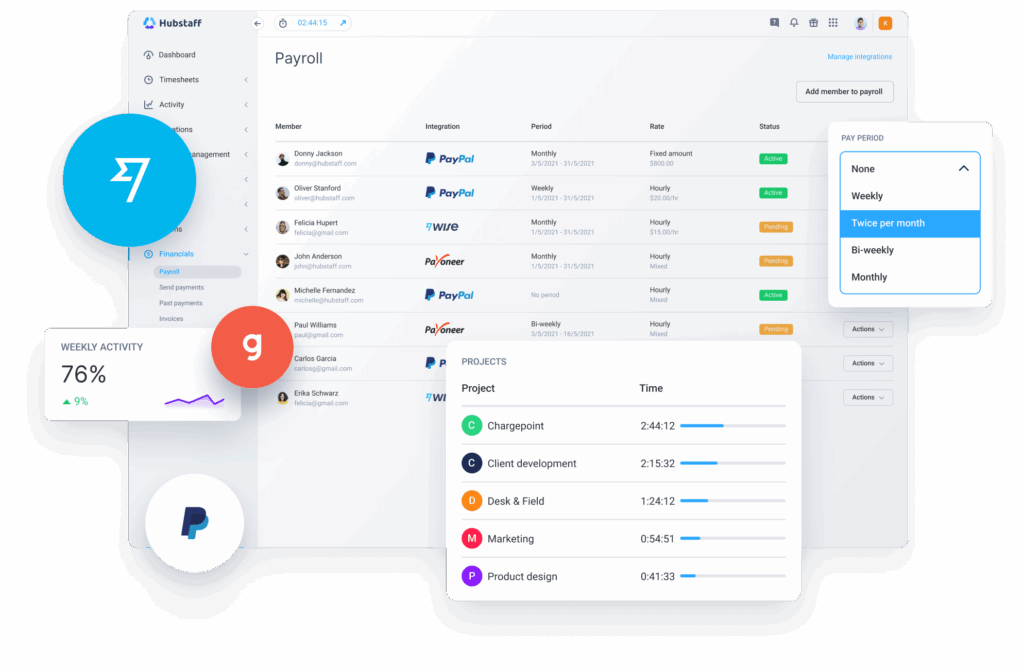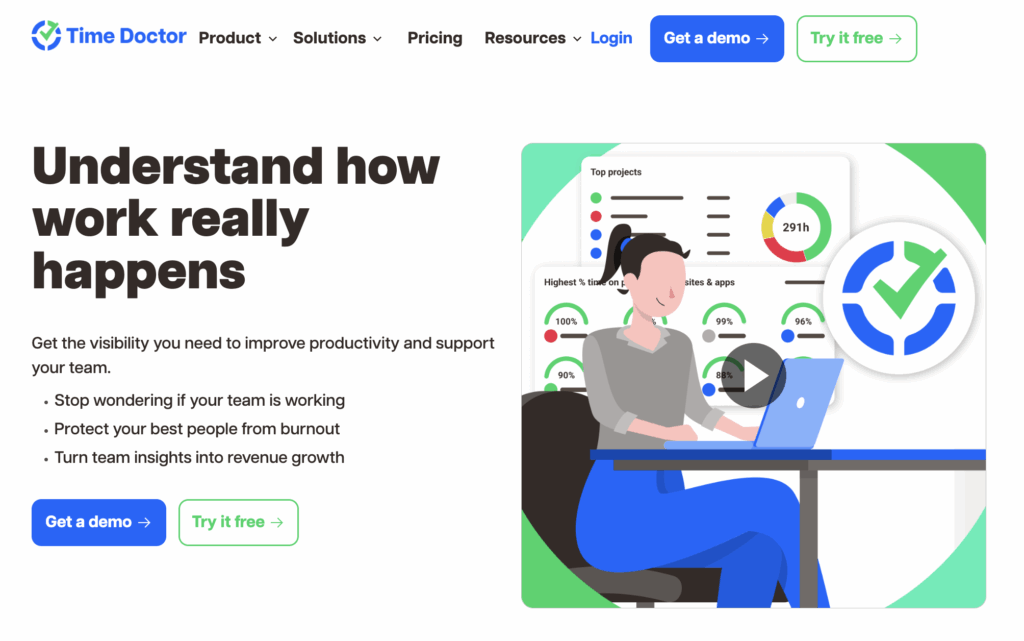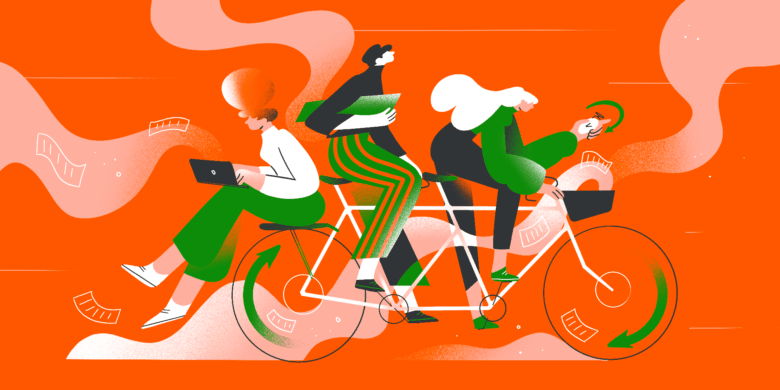“Great art takes time.”
But if you’re a designer, the real quote might be closer to: “Great art takes time… and time tracking software for designers.”
Whether working solo, part of a creative team, or hiring design talent, time is your most valuable (and billable) asset. And unlike more straightforward professions, design work doesn’t always fit neatly into a timesheet.
There’s brainstorming, moodboarding, revisions, and the occasional creative block.
All of it needs to be tracked and paid for. That’s where time tracking apps come in. The right tool can help designers stay focused, avoid burnout, and get paid accurately. It also helps internal teams and clients ensure timelines and budgets stay in check.
In this list, we’ll show you some tools that can do just that. But before we get started, let’s dig into what designers actually need from time tracking software, because not all apps are built with creatives in mind.
Boost your team’s efficiency with Hubstaff's productivity tools
Why do designers need specialized time tracking tools?
“Art is never finished, only abandoned.” – Leonardo da Vinci
Leave it to a Renaissance artist to sum up the core problem with tracking time on creative work: How do you know when something is actually done?
For most hourly jobs, the clock tells the story. A shift starts, it ends, and the time gets logged. But design work isn’t like that.
It’s not linear, rarely wraps up cleanly, and often involves revising the same layer in ten different ways.
And if we’re being honest, sometimes, you stare at the screen doing “nothing” for prolonged periods until an idea finally clicks.
That’s why designers need time tracking tools that cater to the full creative process.
Here’s what that usually means in practice:
- Support for project-based tracking, because most designers juggle more than one brief at a time.
- Easy task switching to reflect the real flow of creative work without losing context.
- Flexible time logging that includes manual entries for the ideas that hit after-hours.
- Client-friendly reporting to clearly show time spent on tasks and projects without needing to justify every stroke or pixel.
- A way to balance accountability and trust, especially on teams where managers want visibility, but creatives want breathing room.
Of course, that balance can go sideways. Some designers overbill, whether intentionally or not. Some clients squeeze for more than what they paid. That’s why clarity is key.
Challenges designers face with time management
For designers, hours rarely unfold in a straight line.
Creative work tends to ebb and flow. Demands from clients, teammates, and the work itself don’t always leave space for deep, focused time.
That’s not a flaw in the designer. Rather, it’s simply the nature of the job.
Here are some of the common challenges that come with the territory:
- Managing multiple projects. Designers are rarely working on just one thing. Freelancers juggle multiple clients, in-house folks bounce between departments, and context switching is seemingly constant.
- Finding time for independent work. Meetings, Slack pings, and rushed feedback loops can break the rhythm needed for meaningful creative progress. Many designers struggle to carve out uninterrupted time.
- Scope creep. Design projects can be hard to estimate precisely, especially when the vision shifts midstream. One small “quick tweak” can spiral into hours of new work.
- Client revisions. Revisions are part of the job, but they’re also hard to plan for. Some clients need one round. Others send five rounds of conflicting feedback. Designers often end up absorbing the time cost.
Even with the best intentions on all sides, these challenges can make time tracking feel like guesswork. But that only makes having the right tools more important.
Benefits of using time tracking for designers
Creative work doesn’t always follow a predictable pattern. Without some structure, it’s easy for time to disappear into the unknown.
Tracking time gives designers clarity and gives clients or managers confidence that the hours logged match the work delivered.
Done right, a time tracking tool can:
- Help designers build accurate, transparent timesheets without the guesswork
- Surface real-time productivity insights without feeling invasive
- Make it easier to pay freelancers, contractors, or full-time team members across platforms
- Allow designers to tag and switch between multiple projects with minimal friction
Beyond just keeping things organized, time tracking can support the creative process. When designers know their time is protected (and that there’s a clear structure around it) it frees up more mental space for deep work.
Time tracking can help prevent burnout, too. Time tracking gives visibility into long hours, overbooking, or constant context switching so designers (and their managers) can adjust before it leads to burnout.
Benefits of time tracking for graphic designers
- Log hours spent on layout iterations, typography choices, and revisions across multiple clients
- Easily separate time for print, digital, and branding projects for better invoicing and reporting
- Spot overbooked weeks early to avoid creative fatigue
Benefits of time tracking for web designers
- Track front-end build time separately from design and planning stages
- Measure time spent on responsive tweaks, QA, and site performance fixes
- Sync tracking with dev tools and client portals to reduce task duplication
Benefits of time tracking for interior designers
- Log on-site vs. remote planning time, especially when billing by location or task
- Use manual entries to capture client consultations and design sessions
- Justify hours spent sourcing materials, managing deliveries, and handling revisions
Benefits of time tracking for UX & UI designers
- Track time across user research, wireframing, prototyping, and testing stages
- Capture feedback and revision loops without losing sight of original estimates
- Tie design hours to specific product features or user flows for better reporting
Benefits of time tracking for design teams
- Compare planned vs. actual hours to improve future estimates
- Identify workload imbalances to avoid overloading key contributors
Benefits of time tracking for freelance designers
- Create polished, professional invoices backed by detailed time logs
- Separate time by client or project to manage deadlines more clearly
- Spot scope creep before it eats into profit margins
The 5 best time tracking tools for designers in 2026
1. Hubstaff: Best time tracking software for designers of all kinds

Hubstaff is a flexible time tracking app for designers that fits right into the rhythms of creative work. With Hubstaff, you can:
- Track time to client projects
- Seamlessly convert hours to detailed timesheets
- Create your invoices, add automated line items, and email them to clients from the app
- Pay contractors, freelancers, and on their preferred payroll tools from one location

For managers of design teams, the real-time dashboard gives you a clear view of work habits, hours logged, what projects people are spending time on, and the websites and design apps they’re using to get the job done.
You can approve timesheets, handle payroll, and keep everything centralized — even if your team is spread across time zones.
Why designers love Hubstaff
Designers like that Hubstaff doesn’t interrupt their flow. It works quietly in the background, picking up time without a bunch of clicks or distractions.
And when it’s time to get paid or report to a client,the records are clean, detailed, and ready to go in just a few clicks.
Key features
- Automated time tracking: Log time through desktop, web, or mobile. Set idle timeouts, track to specific projects, and add manual hours when needed.
- Productivity tools: Get transparency without micromanaging. Track hours worked, websites and apps used, and overall activity from an intuitive dashboard.
- Payroll: Pay your team directly through Hubstaff using integrations with PayPal, Wise, Deel, and more. Supports freelancers, contractors, and salaried staff, no matter where they like to be paid.
- Invoicing & expense reports: Build custom invoices with automated line items and customizable branding and rates. Designers can also log expenses for things like software, stock photos, or travel.
- Hubstaff Tasks (add-on): Manage work with Tasks. Visualize workloads in Timeline, Sprint, or Kanban-style views and see real-time updates on project spend, hours worked, and more for each task and project.
Reviews
- G2: 4.4/5
- GetApp: 4.6/5
- Capterra: 4.6/5
Users across the board highlight Hubstaff’s reliability, flexibility, and ease of use. Many praise its clean interface and the way it helps them stay focused while still giving managers visibility into hours worked and project progress.
See what Hubstaff users have to say
Pricing
Hubstaff offers a free version that’s ideal for solo freelance designers. It includes basic time tracking, timesheets, and limited payment tools.
Paid plans (with more features and unlimited team sizes):
- Starter: $7 per user/month
- Grow: $9 per user/month
- Team: $12 per user/month
- Enterprise: $25 per user/month (annual billing)
Hubstaff also offers add-ons that can be combined with any plan:
- Insights: $2 per user/month
- Tasks: $3 per user/month
- Data retention: $2 per user/month
- More screenshots: $3 per user/month
You can try Hubstaff free for 14 days to see if it fits your workflow.
2. Harvest: Good for graphic designers

Harvest is the tool of choice for companies that know design. With clients ranging from Conde Nast to Volkswagen, this sleek designer time tracker is great for designers looking to stay on top of their projects.
Key features
- Time tracking: Harvest prides itself on ease of use, boasting an industry-standard timer that works across an array of devices.
- Invoicing: Harvest continues with its theme of focusing on the dollars and cents while you focus on design with invoicing features. The last thing you need is another design project, so let Harvest seamlessly convert your timesheet into a formal invoice.
- Expense tracking: Intuitive expense tracking makes it easy to bill for software, stock photography, and any other expenses a graphic designer might incur.
- Reporting: Creating reports is another place where designers waste too much time. Generate simple, accurate time reports for hours worked, budgeting, and more with Harvest.
Reviews
- G2: 4.3/5
- GetApp: 4.6/5
- Capterra: 4.6/5
Pricing
- Free
- Pro: $13.75 per user/month
Premium: $17.50 per user/month
3. Toggl: Ideal for web and UX designers

You know Toggl Track is a legit designer time tracker because it’s made by a former consulting agency that needed a way to track time spent on projects. In fact, the Estonian company pivoted and became the Toggl we know today when clients were so pleased with how well they tracked and articulated their hours.
Key features
- Time tracking: Intuitive one-click timers, reminders, and a sleek interface make time tracking a breeze with Toggl.
- Reporting: Leave it to the former agency pros to handle reporting. Toggl gives users access to intuitive, colorful reports by time, project, or client.
- Project dashboard: Like Hubstaff, the dashboard helps agencies and designers monitor progress, manage budgets, and control deadlines in just a few clicks.
- Integrations: Toggl boasts over 100 integrations, which makes it a seamless addition to any tech stack. Pair it with communication tools like Slack, accounting tools like QuickBooks, and everything in between.
Reviews
- G2: 4.6/5
- GetApp: 4.7/5
- Capterra: 4.7/5
Pricing
- Free: $0
- Starter: $10 per user/month
- Enterprise: Custom pricing
4. QuickBooks Time: Great for Interior Designers

If you’re an interior designer, there isn’t a time tracking tool custom-tailored to your needs. That said, the day-to-day of an interior designer is likely one that involves a hybrid work situation that balances time spent in an office (or at home) and on-site time.
QuickBooks’ versatility also makes it an excellent tool for hybrid users working in the office and on their mobile devices.
Key features
- Time tracking: QuickBooks Time offers intuitive time tracking across various devices and helps interior designers switch seamlessly between in-office and on-site work without losing a second of tracked time.
- Geofencing: Tools like QuickBooks Time offer GPS and geofencing features, allowing hands-free time tracking data based on location. For interior designers, they can set up a job site around a home or other building. When they enter or exit the radius, time tracking features kick in or pause accordingly.
- Integrations: QuickBooks Time seamlessly integrates with other QuickBooks products and various payroll and accounting systems, simplifying payroll processing and enhancing overall workflow efficiency.
Reviews
- G2: 4.5/5
- GetApp: 4.7/5
- Capterra: 4.3/5
Pricing
- Time Elite: $40 base fee + $10/user/month
- Time Elite + Payroll Elite: $134/month + $12/employee/month
5. Time Doctor: An overt tool for remote design teams that need oversight

Time Doctor works well for remote design teams where visibility and accountability are high priorities. It’s great for managers who want to monitor how time is spent across apps and tasks, especially in remote environments.
While it might feel a little heavy-handed for solo freelancers, it can be helpful for agencies or design teams juggling multiple projects and needing tighter time audits.
Key features
- Time tracking. Tracks time automatically while you work, with support for manual entries and idle time detection.
- Activity monitoring. This tool offers screenshots, screen recordings, app usage statistics, and website tracking for teams that need more in-depth monitoring.
- Project and client tracking. Breaks down hours by task, project, or client for better reporting and accountability.
Reviews
- G2: 4.4/5
- GetApp: 4.5/5
- Capterra: 4.5/5
Pricing
- Basic: $8 per user/month
- Standard: $14 per user/month
- Enterprise: Custom pricing
What is the best time tracking software for designers?
The best time tracking software for designers comes down to what your day-to-day looks like. However, if we had to crown a winner, the award would go to Hubstaff.
For designers and managers alike, that starts with:
- Identifying key features to consider
- Comparing costs and benefits
- Considering integrations with your existing tech stack
- Testing the software with a free trial
Even the best time tracker won’t tick every box.
Free versions often have limits like fewer projects, no team features, or restricted support. The goal isn’t perfection, though — it’s finding something that fits your flow and makes the business side of design smoother.
Once you’ve found the right fit, it’s time to implement and make it part of your rhythm.
Time tracking tips for designers
Time tracking can quickly feel like a chore when there’s no structure behind it.
A few small habits can make a big difference in how useful your time data is (and how easy or annoying the process feels).
Here are a few ways to make time tracking stick:
- Set clear goals before you start. Know what you’re trying to measure, whether that’s billable hours, time spent on creative vs. admin, or task estimates.
- Track consistently, not perfectly. You don’t need to catch every second. Just build the habit of logging time as you go or at natural checkpoints.
- Review weekly. Take 5 to 10 minutes at the end of the week to check your time logs. Look for patterns, overages, or work that went off-scope.
- Use analytics. If your tool offers reports, check in on things like time by project, time of day, or idle time. You’ll spot trends faster than guessing.
- Protect your deep work. Block time on your calendar for creative sessions and try not to let meetings or context-switching eat into that.
- Be honest. Time tracking isn’t about “looking productive.” Focus on getting good work done, not scoring nice activity numbers.
How to implement time tracking in your design workflow
Once you’ve picked your automatic time tracking tool, the next step is getting it to work in the real world.
The good news? Tools like Hubstaff make setup easy. Most time tracking apps follow a similar setup flow.
Here’s how to roll it out without overcomplicating things:
- Install the tool. If it’s a desktop or mobile app, go ahead and download it. If you’re using a browser-based tracker, you can skip this part.
- Create an account. Sign up, choose your plan, and walk through the initial setup. Most tools will prompt you to customize dashboards, workspaces, and a few basic preferences.
- Invite your team. If you’re not solo, start bringing people in — freelancers, in-house designers, contractors. Group them into teams or projects as needed.
- Customize your settings. Set billable rates, assign roles, and make sure everyone has the right permissions. It’s also a good time to establish naming conventions for projects and tasks.
- Set up integrations and payroll (if needed). Connect your accounting or payroll tools so you can handle invoicing and payments straight from the app. Hubstaff, for example, plays nice with PayPal, Wise, and QuickBooks.
- Test everything. Before rolling it out across the team, do a dry run. Track some test time, generate a fake invoice, and make sure the settings feel intuitive. Fix anything clunky before going live.
- Start tracking. Start using the tool during real work. Encourage the team to track consistently, note any snags, and refine things as needed.
Getting the setup right upfront means less confusion down the line and fewer headaches when it’s time to invoice, report, or review project hours.
Design case studies and success stories
At Hubstaff, we’ve helped numerous designers and businesses with design teams find their way with better time tracking. Here are some examples of those we’ve helped in the design space:
Pubsphere
Canadian trade show company Pubsphere stays ahead of the competition with help from Hubstaff. Their business spans multiple continents and job sites, so global payroll and geofencing features have been enormously helpful.
Rise
This Philadelphia-based web design company turned to Hubstaff to consolidate time tracking and keep track of billable hours for clients between pay periods.
Frequently asked questions (FAQs)
Why is time tracking important for designers?
Time tracking helps designers (and companies employing them) manage workloads, bill more accurately, increase productivity, and keep projects in scope by meeting deadlines. The best tools, like Hubstaff’s Time Tracking App for Designers, also provide insight into time spent on different apps and projects to optimize workflows.
What features should design teams look for in a time tracking app?
That depends on your unique needs. First and foremost, you’d want to find an intuitive time tracker that integrates with payroll tools. This way, you can pay teams seamlessly on their preferred platform. Productivity insights may also help check in on remote employees, freelance designers, and contractors.
How can time tracking improve a designer’s productivity?
By tracking time, designers can focus on what they do best: creating. Idle time detection, hourly limits, and other productivity features help designers stay on track and not have to shift gears to focus on timesheets and invoices. This can then help increase productivity.
Can time tracking tools integrate with my design software?
Many time tracking tools offer integrations with accounting, payroll, and project management tools. Before making a final decision, ensure your tool integrates with your existing tech stack.
Conclusion
Time tracking might not feel like a creative tool — but for designers, it can be one of the most practical ways to protect your time and your income.
The right time tracker helps bring structure to something that’s often hard to pin down. It helps you bill fairly, avoid burnout, spot scope creep early, and stay focused on the actual work instead of the admin around it.
No tool is perfect, and getting started might take some trial and error. That’s normal. What matters is building a workflow that’s sustainable for you, your team, and the kind of creative work you want to keep doing.
Pick a tool, test it properly, and don’t skip the setup details. Once it clicks, time tracking goes from a chore to something that just runs quietly in the background.
Most popular
How to Choose the Right Employee Attendance Tracker for Your Team
An employee attendance tracker records time spent on the job, absences, late or abandoned shifts, and other valuable information....
How Agencies Can Leverage AI & Time Tracking to Increase Profits
Why AI Is Powering Agencies, But It’s Missing From the Data Agencies are adopting AI faster than ever – using it for research,...
How to Track Remote Employees Effectively in 2025
Remote work has become the default for many teams, and for good reason — it’s efficient, flexible, and often more productive t...
The Complete Guide to Staying Audit Ready and Compliant with Hubstaff
No one looks forward to an audit. Even when you know your records are clean, stress levels are high — but not with this helpful...




